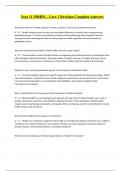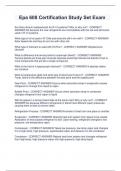Year 11 PDHPE - Core 1 Revision Complete Answers
What does the term "health inequities" mean, and why is it a focus for health promotion?
✔️✔️ Health inequities are the unfair and avoidable differences in health status among various
population groups. It is a focus for health promotion because addressing these inequities ensures
everyone has the same opportunities to achieve optimal health, regardless of socioeconomic or
geographic factors.
How does the biomedical model of health differ from the social model?
✔️✔️ The biomedical model of health focuses on diagnosing and treating diseases at a biological level,
often through medical intervention. The social model of health, however, considers a person's social,
environmental, and economic conditions as critical factors influencing their health and well-being.
Explain the term "priority population groups" in the context of Australia's health.
✔️✔️ Priority population groups are specific segments of the population that experience higher health
risks and inequities. In Australia, these include Indigenous Australians, low socioeconomic communities,
rural and remote populations, and individuals with disabilities, who require targeted health
interventions and support.
Why is mental health an increasing priority in Australia's health landscape?
✔️✔️ Mental health is an increasing priority because of rising rates of mental health issues, such as
anxiety, depression, and stress, which affect a significant portion of the population. Mental health
impacts overall well-being, productivity, and quality of life, prompting a need for comprehensive mental
health services and awareness.
Describe how health can be viewed as a continuum.
✔️✔️ Health as a continuum recognizes that health is not simply the absence of disease but a range of
conditions from optimal wellness to severe illness. People may move along this continuum based on
lifestyle choices, environmental factors, and health conditions.
What role does media play in influencing perceptions of health in Australia?
, ✔️✔️ Media influences health perceptions by shaping public opinion on health issues, promoting
certain health behaviors, and highlighting health trends. Both traditional and social media can raise
awareness but also contribute to unrealistic health standards and misinformation.
Explain the importance of self-assessed health status as a measure in public health.
✔️✔️ Self-assessed health status is essential as it provides insights into how individuals feel about
their health, often capturing mental, physical, and social well-being aspects that may not be evident in
clinical assessments. This subjective measure can help identify emerging health trends and the need for
resources.
How does the built environment impact the health of individuals and communities?
✔️✔️ The built environment, including urban design, transportation, and access to green spaces,
significantly impacts physical and mental health. Safe and accessible environments encourage physical
activity, social interaction, and lower stress, contributing to better health outcomes.
Discuss why Aboriginal and Torres Strait Islander populations face unique health challenges.
✔️✔️ Aboriginal and Torres Strait Islander populations face unique health challenges due to historical,
social, and economic disadvantages. Limited access to healthcare, cultural differences, and higher rates
of chronic diseases contribute to health disparities that require culturally sensitive health strategies.
What is the importance of early intervention in managing chronic diseases?
✔️✔️ Early intervention is crucial in managing chronic diseases because it can slow disease
progression, reduce complications, and improve quality of life. Preventive measures and timely
management strategies can help individuals maintain better health for longer periods.
Describe the relationship between morbidity and mortality in population health.
✔️✔️ Morbidity refers to the rate of illness within a population, while mortality is the rate of death.
High morbidity can lead to increased mortality over time, especially if diseases are left untreated or
poorly managed, making both indicators critical in assessing public health.
Explain how "protective factors" contribute to positive health outcomes.
✔️✔️ Protective factors, such as a supportive family, good education, and positive social networks,
help reduce health risks and promote resilience. These factors enable individuals to make healthy
choices, cope with stress, and prevent the onset of physical and mental health issues.





